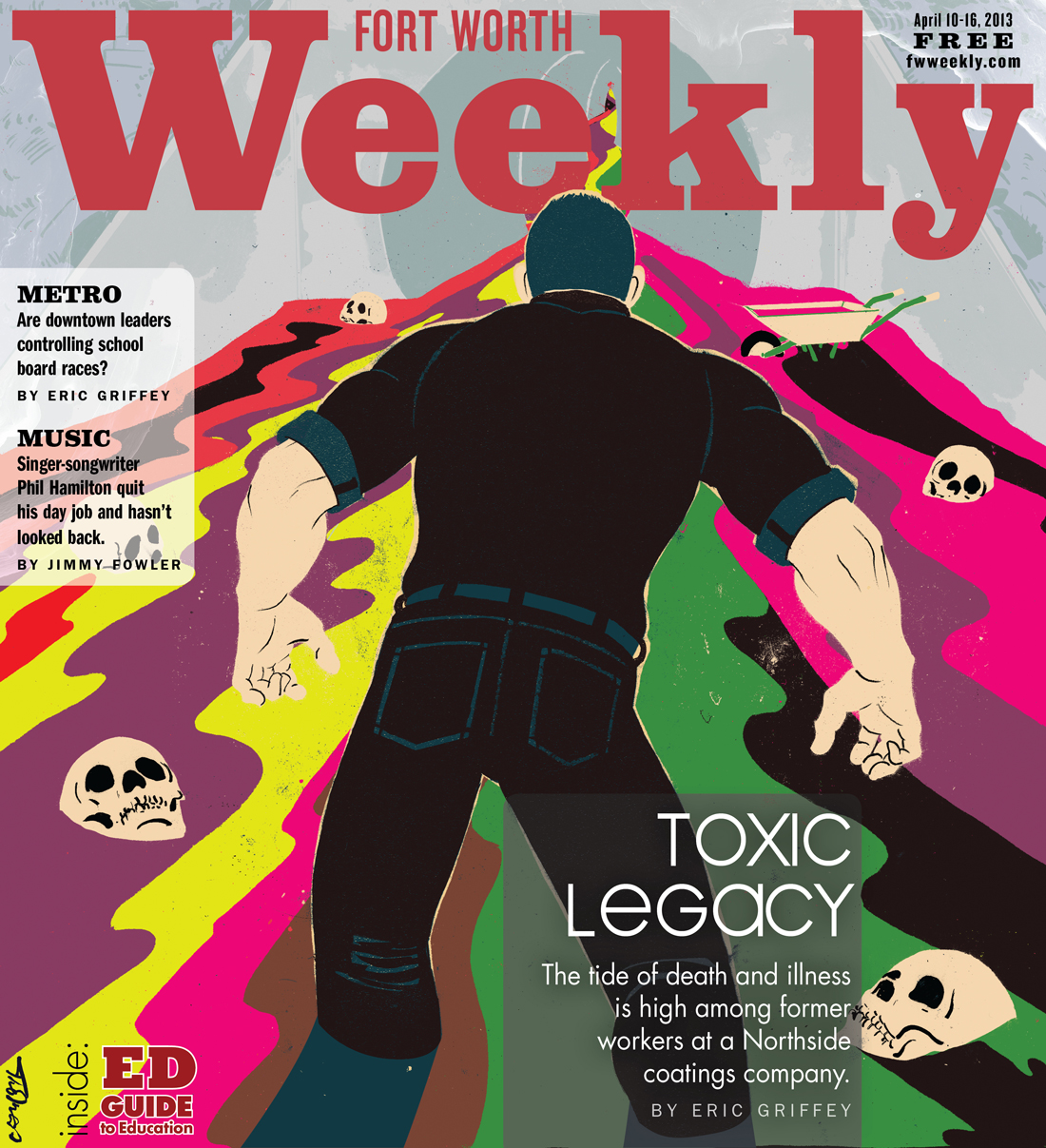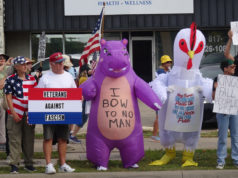Wayne Morris was as dedicated an employee as a company could want.
For 13 years, he worked as a maintenance man for a small business called Southern Anodizing, which was eventually bought by Technicoat, a metal coating company based in Fort Worth. The company applied chemical coatings on everything from missiles to waffle makers.
Morris’ job involved crawling around in dangerous chemicals, often dumping the hazardous material into underground pits and sometimes down the storm drains when the pits were full and his supervisors wanted to cut corners.
As his three sons came of age, Morris got jobs for them at the company. As teenagers, the boys were asked to perform the same tasks as their father. Robert, the youngest of the three, said he routinely waded in foul-smelling chemicals with no protective gear or safety training.
“We didn’t have any aprons, any face masks, gloves, nothing,” he said. “We didn’t do things as safe as we could. We were just told to get the job done.”
From the 1970s through the early ’90s, the years when the Morris family members worked at the Fort Worth coating factory, environmental and safety regulations were not enforced as strictly in this country as they are now. Still, according to language in the Occupational Safety & Health Act of 1970, Technicoat’s practices violated federal safety standards.
Wayne Morris died in 2001 after a long, painful fight against stomach cancer. Now two of his sons are dealing with serious medical problems that they believe are related to their time at Technicoat. And they aren’t the only ones.
The company’s old employee roster reads like an oncologist’s former patient list. An alarming number of Technicoat staffers have passed away from cancer, heart disease, or illnesses that are linked to chemical exposure. The two Morris brothers, who now live in Arkansas, fear they may suffer the same fate as their father. Robert worked at Technicoat for five years, and Gary for six. (A third brother, Joe, worked there for a shorter time and has had much less severe medical problems.)
A recent toxicology examination revealed that Robert, now 54, has dangerously high amounts of barium in his blood. That’s one of the carcinogenic chemicals that Technicoat used in its coating for missile launchers.
He also has high levels of trichlorethylene, another chemical used at the plant. It causes blood vessels to constrict and leads to kidney and liver damage.
“According to my doctor, I’ve got holes in my kidney and liver,” he said.
“All three of us have peripheral neuropathy,” he said. “I believe my nerves are dying. I went to a neurologist and did tests, and all three of us have high blood pressure.”
Robert’s doctor at the University of Texas Southwestern Medical Center told him that his current ailments were most likely caused by his contact with the toxic chemicals used at Technicoat.
His older brother Gary, who worked at the plant from age 14 to 20, lives on Social Security disability payments and hasn’t been able to work in years. He said his medical problems have sapped him of his strength: His lungs are scarred, and he can’t stand for long periods because the peripheral neuropathy has weakened him. He said a doctor told him the scarring could have been caused by the chemicals he used to work with.
“It’s hard to describe the pain, other than it’s getting to be unbearable,” Gary said. “I used to be able to grab and hold onto stuff, and now I can’t. And I can’t stand very long.”
The chemicals that now course through the blood of the Morris brothers are among the same ones that they and their father routinely dumped into the ground beneath the plant’s location, just north of downtown near the corner of Calhoun and 6th streets, and into the Trinity River.
“When the pits were full, our supervisor told us to dump the waste into storm drains,” said Robert.
Technicoat moved in 1991 and is now located in Bryson, northwest of Fort Worth. It has merged with another company, Aero-Marine Engineering.
The longtime owner of the plant, Felton Havins, sold the Calhoun Street property to the city in 2001 and has since died. Before selling the two-acre plot, he was fined $158,880 by the Water Commission, a predecessor of the Texas Commission on Environmental Quality, and was forced to begin an ongoing cleanup of the land.
For the city and the Tarrant Regional Water District, the Technicoat site has been a major headache. The city spent more than $3 million to remove the underground tanks and pits that held the poisonous chemicals, along with surrounding soil. TCEQ demanded the water wells be capped. A rubber membrane was placed over the entire plot, and it was paved over.
The land is now a part of the parking lot for LaGrave Field. By city ordinance and TCEQ order, the area can never be built on.
The water district, meanwhile, is planning to eventually resell the surrounding land for luxury apartments, retail, and restaurants as a part of the Trinity River Vision and is responsible for frequently testing the water quality in the adjacent section of the Trinity River and nearby water wells. Environmental Director Woody Frossard said that the site’s poisonous past no longer poses a threat to the public.
“There could well be some truth to [Morris’] claim,” he said, “but the data doesn’t demonstrate that level of contamination anymore. It doesn’t exist today.”
********













Eric,
I would like to say, Thank you from my father and mother. I would also like to say thank you from my brothers Joe and Gary. And most of all I would like to say thank you! I hope all who reads this story of Fort Worth’s past and still present hazardous chemical site. I understand that the EPA states the site is safe. But there are us the victims of the negligence of a company whose only concern was their prosperity.
Robert Morris
I was doing a search on sick people around this area because of my own neuromuscular disease which is very rare and I found this article. I have been sick many years now and I was raised in White Settlement playing in a creek right next to then General Dynamics. I have odd seizures that are not epilepsy related and constant pain in my nervous system that they cannot figure out. The girl that lives behind me also struggled with nerve pain and she was a picture of health and beauty until around 5 years ago when it finally took her life. Her name was Sharon. I honestly believe that whatever they are doing in that place spills over into the community and we are the ones who suffer for it. I just moved back to Fort Worth after many years in Arkansas getting married and raising children and living in the first trying to remain as healthy as possible. Coming back I am finding out that there are so many who have had children with major health problems and fertility problems who lived around the same area and there seems to be no help in sight. I’m not wanting to sue anybody but I sure do wish that company would admit that some of the things that they are doing over there has made us sick and that they would pay for a good doctor and medications. I suffer everyday with pain in my nervous system around my spine and with headaches. The neurologist that I seen in Arkansas was calling this myasthenia gravis but I’ve had three other doctors tell me that it is not myasthenia gravis that it is something else that has affected my nervous system.
Where is this place, on the Trinity?
I was a supervisor for around five years at southern anodizing at the time the Morris’s worked there.
I was young and uneducated as we’re many of the people we hired. I knew Felton Havins jr personally after working for him at meachum field.
I went to work for Felton jr. And became close to Felton sr.
It was my job to take the work in at the door, supervise processing and ship.
As time went by I started becoming ill. I would get sores in my nose, my mouth. I would have days when I felt as if it was a struggle to even get off the forklift. Anxiety and depression started setting in.
I did not realize it was my place of employment at the time.
Dr. Hieberto Pena on north main was my doctor and he told me that place was going to make me sick. He was wrong it already had.
After a year at general dynamics I woke up one morning and started crying. I mean boo hooing and bawling. I had never cried in my life till that morning and remember it well. It was 1981 and I have been fight depression tooth and nail ever since. I had to quit working as soon as I made a pension, only because Lockheed is a great company that understood.
I personally supervised the disposing of chemical waste at la grave field.
I was told to get rid of the five hundred barrels of dirt that lined the fence in the back of the facility. I did not know what it was at the time. After learning I started making calls in the 1980’s and got no where. It seemed as if no one wanted to know. I called OSHA I called various federal agency’s only to be told I would most likely go to prison if I persisted. I gave up.
After learning of the resurrection of Lagrave field I called a few more places.
Finally I started digging into EPA websites after the advent of the Internet.
I found records of mr Havins have been fined and let off light.
The city of Fort Worth just swept all this under the rug, put a cap on the top round and started taking admission fees.
I do not go to Lagrave field.
I have a lot of story to tell about this place.
The triclorethlene, I hated running that tank. For days afterward it tasted as if you had ingested sugar in your lungs to the point it would make your throat sore.
Methel ethel keystones, MEK, we would use 150 gallons in a shallow tank mix in 100 gallons of phenolic coating, and dip heat exchange coils in the mixture. We had a circus tent canvass that I hung up,in front of the buildings gas heater, to accelerate drying.
It gotta to the point that every time we processed a batch my kidneys would start hurting.
The cyanide from the cadmium plating would wake you up at night with burning under the finger nails.
This goes on and on.
I was so glad to find this artical. I haven’t spoke to seen the Morrises since those days so many years ago and want them to know I am on Facebook.
Mike Shelton.
Mike,
I would like to say thank you for stepping up, and testifying about your time at Technicoat. Also to all of the other people that put in comments. This really means a lot. It will be a monumental task to get this rendered into a case. Have any one of you thought of contacting Erin Brockovich, she is a consumer advocate. Check her out on her website. The more we get involved the better we are as a team.
This is such a sad commentary about corporate/government collusion and the lack of empathy for anyone or anything besides profit.
Despite environmental and safety regulations, these men toiled without sufficient safety gear to prevent or even reduce exposure to deadly toxins. It is sickening to hear industry now cry out for less regulation!
I hope the victims of that work environment and the future victims of the existing site have some opportunity to secure compensation from the profiteers of this hell they created. I hope the clean-up no longer falls on the taxpayer, as it has.
Very sad this happened to hard working people. 🙁
I think the people who owned this company should be held responsible for the pain and suffering of these workers. Shame on the city of Fort Worth for once again ignoring the citizens who are not members of the wealthy elite.
I worked in Department 31 for 10 years at General Dynamics/Lockheed where we used MEK, lead tape, and various other chemicals every day. Then I was in Department 39, Etch and Plating, for 5 years at General Dynamics/Lockheed. After getting laid off in 1993 I went to Bell Helicopter Textron, Plant 5, in Grand Prairie. At Bell I worked as a “Machined Parts Precision Finisher A” and an “A” Plater in Plating. At Bell we were dealing with MEK, Tolulene, Caustic Soda Acid Flake, Black Magic, Powdered Blue Coat Epoxy, Cadmium, Sodium Hydroxide, Anodize, Lube Lock, Black Oxide, Silver Plate, Dow finish, Chem Film,
Cromate. I now have C.O.P.D., Crohn’s, Crohn’s Colitis, and damaged lungs. I know it was due to all the chemical exposure and that is what my doctors believe as well. I was also involved in Safety Training and did my best to protect myself. However, we were not made aware of Safety practices until the late 80’s after we had all been exposed for several years. Our generation made sure they stopped using MEK in most open areas, and we are the reasons they began the ISO 9000 series Safety Classes, and Respirator Classes. We were also given Safety Classes at our I.A.M.&A.W. District 776 Union Hall. OSHA and the EPA, amoung others, were called in and General Dynamics & Lockheed were fined many times. They were also called in at Bell Helicopter and they were also fined many times. Many of the ones I worked with at General Dynamics/ Lockheed, and also Bell Helicopter, have passed away from various cancers and illnesses related to the exposure. The ones of us still alive, most of us have health problems related to the exposure as well. This is a very serious issue. I was glad to see this article posted on here.
I can confirm Mike Shelton’s comments. I too was a TechniCoat employee. Looking back, I see how badly the folks that worked for Felton Sr were treated. I personally saw how he instructed those young men to physically, get down into those de-greaser tanks. One in particular (Wayne Bradberry) died from cancer at a very young age.
My sister, also worked for TechnCoat. She developed a cancerous brain tumor which took her life. My sister in law, who worked there has cancer now, our family prays she can be treated successfully. My brother, also worked for TechnoCoat and now has severe liver and adrenal disease.
These facts are just in my immediate circle. It seems like there should be an investigation, even at this late date.
Becky Essner
This simply should not have happened.
Becky,
Who was your sister? Did I work with her? I remember a Janice Humphries, a Donna West, Diane Miley, and Martha Flores. Has any one else filed for workers compensation?